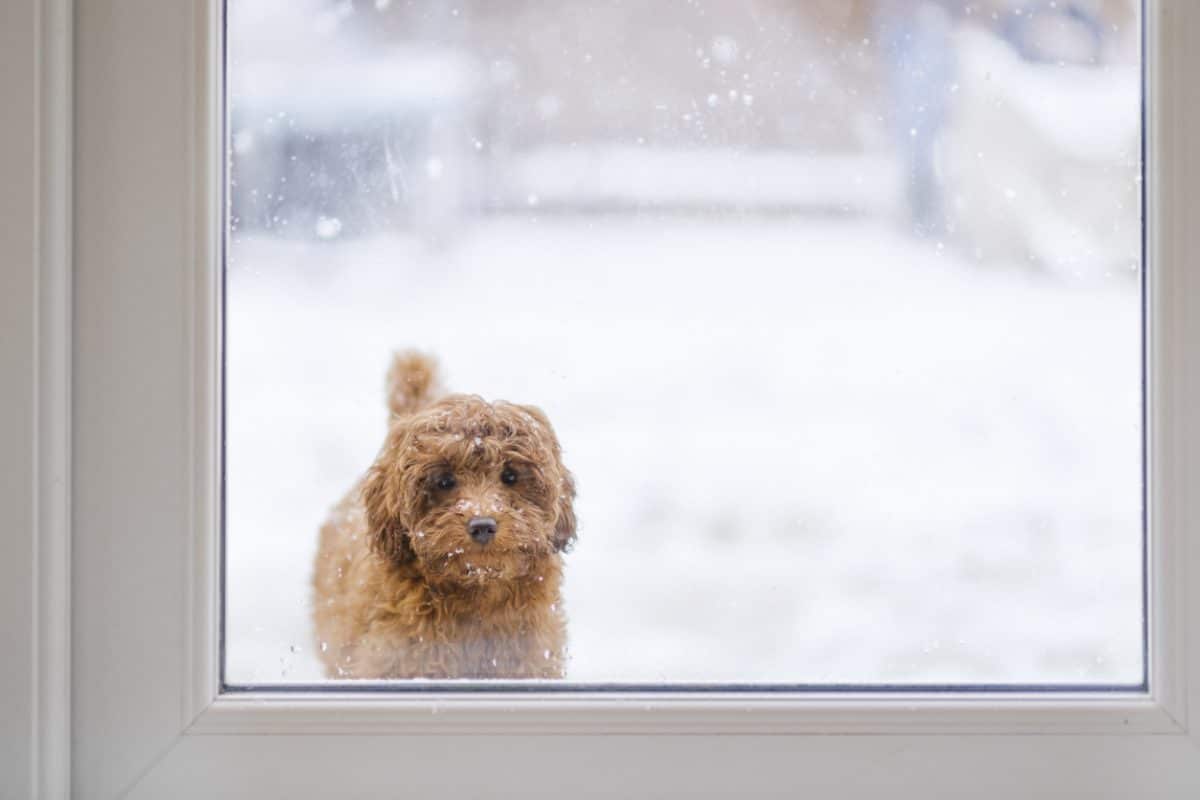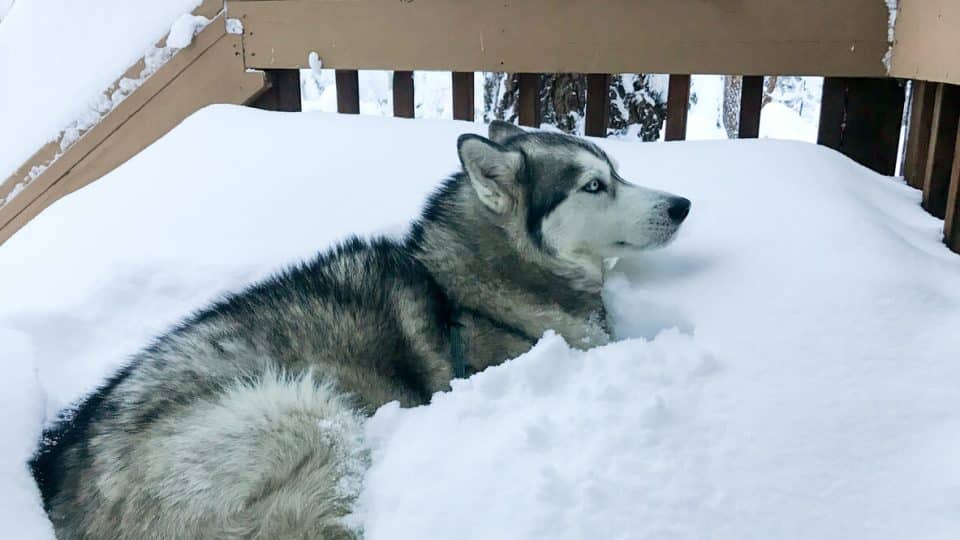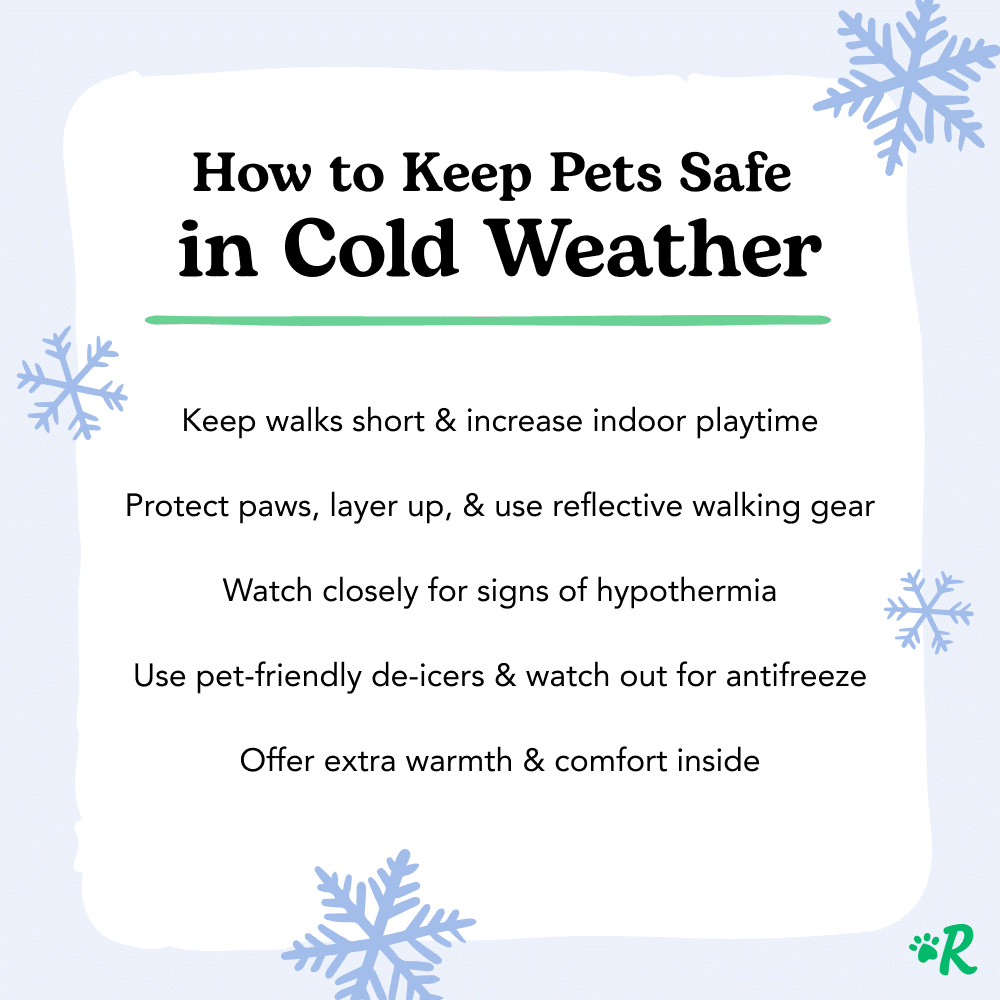- Not a substitute for professional veterinary help.
We all know that familiar shiver when temperatures drop in winter, and dogs feel it, too.
When dogs become exposed to the cold for long periods, they can develop hypothermia. Hypothermia happens when their body temperature drops dangerously low, resulting in mild to severe symptoms such as shivering, frostbite, and in extreme cases, death.
So, how cold is too cold for a dog? And what are some of the other factors that can influence how a dog might react to the cold?
We’ll go over the temperature thresholds below and help you recognize the causes and symptoms of hypothermia in dogs. Plus, you’ll also get insight on helping your pup stay warm and toasty on cold days.
What Is Hypothermia in Dogs?
Hypothermia happens when a dog’s body temperature falls below the normal range, which is generally from 98° to 101°F. When this happens, the body loses heat faster than it can be produced, and serious complications can arise.
What Causes Hypothermia in Dogs?
Hypothermia can occur as a primary or as a secondary condition.
- Primary hypothermia occurs when a dog spends too long in a cold environment, such as prolonged exposure to freezing temperatures.
- Secondary hypothermia happens as a result of another medical issue, like hypothyroidism, hypoglycemia, or sepsis. Additionally, around 40% of dogs and cats develop hypothermia under anesthesia.
The following factors could impact your dog’s chance of developing primary hypothermia.

iStock/EllenMoran
Environmental and breed considerations
Generally speaking, pets that aren’t used to cold weather shouldn’t be left outside in temperatures below 45 degrees Fahrenheit.
However, a dog’s breed can make a big difference in terms of cold tolerance, says Dr. Paige Adams, DVM, a veterinarian with Etowah Veterinary Hospital in Marietta, Georgia. “The sporting, working, and herding breeds that were bred for jobs are usually much more tolerant of working in colder weather.”
Alternately, smaller dogs or breeds with shorter coats can find it trickier to regulate their body temperature. Examples include sighthounds, like Whippets and Greyhounds, and toy breeds, like Chihuahuas and Yorkies.
Another breed consideration is the climate where you live. For example, a snow dog acclimated to living in sunny California will have a harder time withstanding cold, snowy weather during a Montana winter.
For the most part, no matter the breed, if a pet is used to being indoors, they can be at risk of hypothermia if they aren’t properly acclimated to the cold.
Medical issues
Dr. Jessica Taylor, DVM, Vice President of Veterinary Medicine at Petfolk, an online veterinary service, says pets with medical issues, such as a heart or respiratory condition, are particularly vulnerable to hypothermia.
“Any underlying disease can put pets at risk, as hypothermia affects multiple body systems,” Taylor explains. “From the skin to internal organs, such as the kidneys and digestive tract, all suffer when the body temperature is too low.”
Age
Your dog’s age can also play a role. For example, newborn puppies and older dogs are less able to retain heat, while smaller dogs “generally have less body mass, leading to more rapid drops in temperatures,” says Taylor.
Activity levels
“The more active a dog is, the better it will handle the cold,” Adams says. She explains that vigorous activities, like running, will help your pup stay warm because it increases their internal temperature.
On the other hand, a slow walking dog who only wants to casually sniff his surroundings may start feeling the chill sooner.
Hair type and hygiene
Dogs with longer hair run the risk of collecting snow on their feet, trapping the cold longer. Trimming the hair around the paws and keeping your dog’s nails short can help prevent prolonged contact with cold surfaces or snow.
Recently groomed pets may be also be vulnerable to hypothermia, Taylor explains. “If your pet has been groomed and their normal hair coat altered, they may be at higher risk,” she says. For example, pets with double coats, such as Samoyeds, Shiba Inus, and Huskies, should never be shaved or trimmed, as this can interfere with their coat’s ability to retain heat.

iStock/Ivar Østby Simonsen
Symptoms of Hypothermia
There are three different stages of hypothermia, from mild to severe. Dogs with mild hypothermia (90-99°F/32-37°C) may shiver or seek heat sources; dogs with moderate hypothermia (82-90°F/27.7-32°C) may stumble or have difficulty walking, be curled or hunched up, or may act confused or sluggish; dogs with severe hypothermia (68-82°F/20-27.7°C) may have have slow or labored breathing or lose consciousness.
When to see a vet
Severe hypothermia can lead to death. Dr. Rebecca Greenstein, of Rover’s expert Pet People Panel, says pet parents should be vigilant and “watch closely for signs.”
“Feeling your dog’s ears is a great way to tell their temperature. If they feel cold, especially around the edges, that’s a sign to get inside. And if you notice your dog shivering in the cold, immediately move them indoors and begin warming them slowly by rubbing their paws while also calling your vet about next steps.”
If your dog is lethargic, reacting sluggishly, shivering uncontrollably, or their limbs are cold to the touch, Adams also recommends contacting a veterinarian. “If something isn’t right, then it’s better to get it checked out than wait until it becomes something more serious,” says Adams.
How to Treat Hypothermia in Dogs
The best way to treat hypothermia in dogs is prevention—always keep an eye on your dog and take the necessary, common sense steps to keep your dog safe, warm, and dry.
In the event that your dog is hypothermic, once at the vet, the usual treatment is to start a gradual re-warming process. At the clinic, your dog may be given treatments such as thermal blankets, infrared lights, or even IV fluids.
Additionally, some simple first aid steps at home can make your dog feel more comfortable before you visit the vet. Taylor recommends:
- Using a towel to remove moisture from the coat. “[This] may help slow down additional cooling,” Taylor says.
- Layering fleece or thermal blankets to kick-start the warming process.
- Giving your dog warm bone broth to drink.
- Increasing your room temperature to at least 75-78°F (24-26°C).
“Do not use electric or other warming procedures,” Taylor says, “as these can cause burns or worsen their condition by warming too rapidly.”

iStock/PK-Photos
How to Prevent Hypothermia in Dogs
In extremely cold weather or during heavy snow, Greenstein suggests keeping “walks short and ramping up indoor playtime.”
“During colder months, shorten your normal walking routine and focus on getting your pet’s energy burned off indoors with extra playtime,” she says. “In extremely cold weather or heavy snow, it’s best to try to limit outside time to quick potty breaks only.”
To make the most of your time indoors, you can offer your pup an enrichment activity such as a puzzle game or lick mat, try working on your bond with some training, or have some fun one-one-one time with a game of tug or binging your favorite TV show.
Some dogs won’t understand what “too cold” means and will be determined to go outside no matter what (we’re looking at you, Malamutes)! In these situations, the experts at Cornell offer the following tips to help keep them as warm as possible.
- Keep your dog active. Adams suggests keeping your dog moving to keep their internal temperature up. Chasing snowballs, jumping in snow piles, keeping walks fast and brisk—whatever motivates them to stay active.
- Wipe your dog’s paws. After a walk, make sure to wipe away any snow stuck to your dog’s paws. Paw balm applied beforehand could create a soothing protective layer. Or, if your dog will tolerate them, booties could keep the snow off their feet in the first place.
- Cozy up with a sweater. A dog coat or sweater can help preserve your dog’s body heat. Adams likes “horse blanket style” jackets for her own dogs since they drape over the shoulders and back, allowing for a wider range of movement.
Hypothermia Is a Serious Condition
The colder months can pose various health problems for our furry friends, but hypothermia is one of the most serious. If the external temperature reaches 45°F or lower, it’s best to keep your furry friends inside. Keep the outdoors for potty business only, and focus on getting your pup’s energy out indoors with puzzle toys or sniffing games instead.



